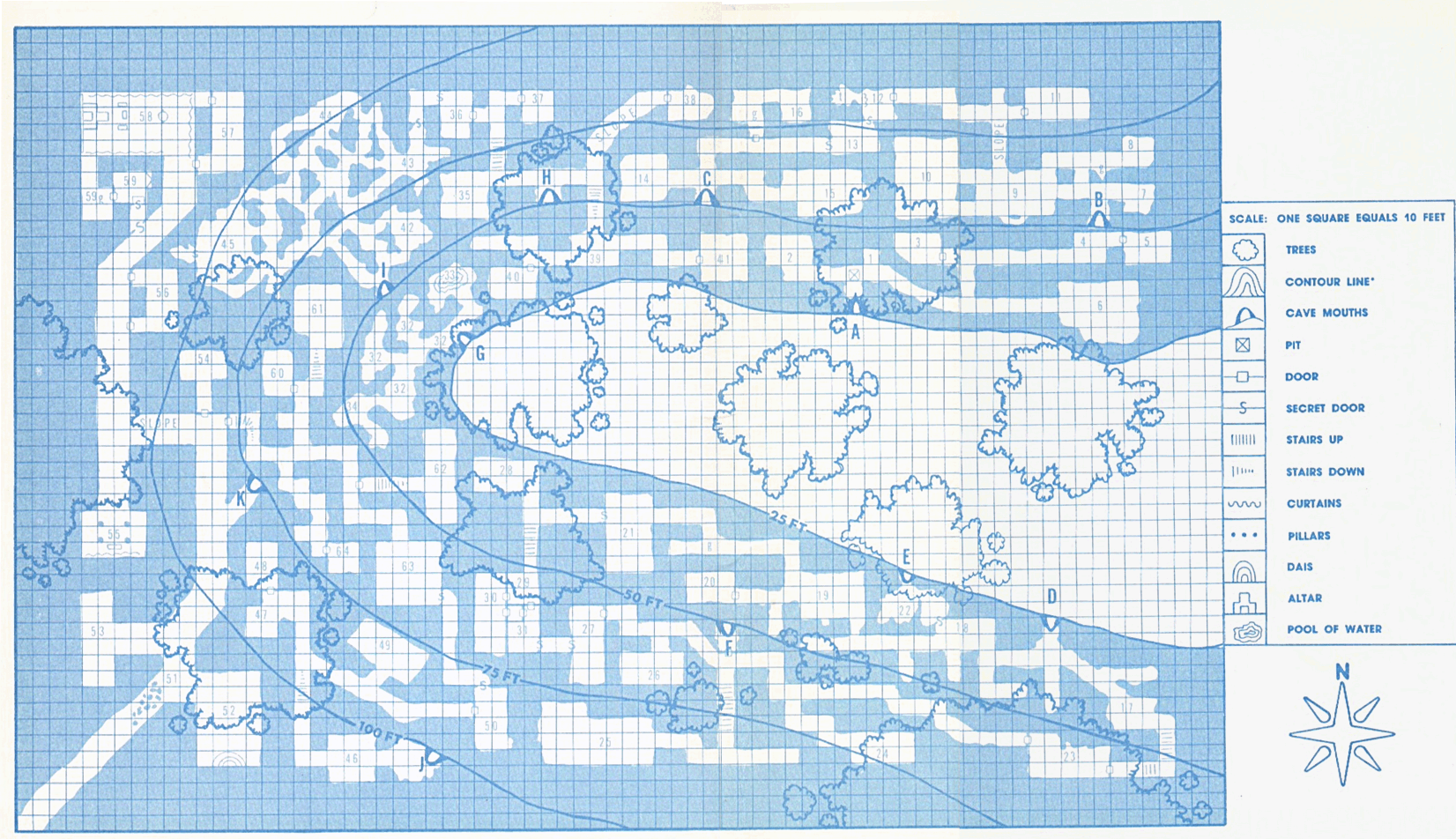That's not to say that the site itself is bland by description, or that no thought has gone into who lived there before, whether or not it was freshly excavated, etc. It's possible to put a great deal of thought into those matters while putting relatively little into the actual physical shape and configuration of the site. Paper, particularly graph paper, has a reductionist quality to it that tends to make me think in simple, concrete, flat terms. The best counter to this that I can think of is the map from the Caves of Chaos (below) which details the topographical detail of the dungeon. This is a perfect example, because not only do we see the hillside slope, we are also privy to a number of non-connected cave systems that undermine the hill. No simple and straightforward maze of caverns, this.
Of course, in a pinch (when you aren't putting together something over a period of days but need something for that evening) you can simply make a random assortment of rooms and assign them purposes. That's helped get me out of many tight squeezes as a DM, I'm ashamed to say.* However, I must take care to ensure that these slapdash dungeons don't take over the work of real dungeon creation. I'm sure someone, somewhere, has categorized the types of dungeons that exist by physical morphology but I don't where that list might be. So here are my categories:
Linear. The laziest and most unrealistic dungeon, this is simply a series of rooms that are joined by corridors. Some may loop back, but it is essentially forward-moving, pushing the PCs to a final room or encounter. If you couldn't tell, I strongly dislike this type of dungeon.
Simple Branching. These dungeons have various branches that do not inter-connect. There may be two branches or more. This requires the PCs to return to past branches to explore the entire dungeon.
Complex Branching. These types of dungeons have inter-connecting branches with back-loops and cut-throughs. There are actually several types of complex branching dungeons I can think of off the top of my head, including the Wheel (central area that expands to many branches) the Tree (trunk area that divides into various branches as it goes deeper into the dungeon) and the Depths (essentially a series of non-linear branching dungeons that fork off each other; what we would generally call a MEGAdungeon).
Looped or Mobius. These dungeons are the type that I'm most prone to make if I sit down to draw. They have a certain appeal; like complex branching dungeons, there are different zones. However, unlike complex branching dungeons these zones are often shot through with interconnections that can cause the players to wind up back at the entrance, in another zone, or back at the central point. There is a danger in overusing this type of dungeon, I feel, especially when you, like me have a tendency to make...
- The Bounded Looping Dungeon. This type of dungeon has all the loops and zones, but there are choke-points that prevent advancement to the next zone or funnel them through a single area. I do this ALL THE TIME to divide the dungeon into inner and outer areas. It's a bad habit.
The best dungeons are those that are concept-built outwards. What does a kobold warren look like? What does a series of dangerous caves look like?, etc. These considerations of real-world morphology** lead to a more interesting and varied structure. There is nowhere as deep or broad to draw from than from life.
*On the other hand, I am also currently running 2-4 active games a week, so I can't always get myself to focus on making notes for this or that one.
**I suppose a kobold warren isn't "real world" but we can model it on some real world things, such as ant colonies.


Regarding real world morphology: You can even take plans of something real from the net, and voilá! Dungeon! ;)
ReplyDeleteThe first two, above ground levels of my own megadungeon are a real monastery. Makes for interesting mapping challenges, but feels ... well, real.
Absolutely.
DeleteGoogle image search on "ant colony cast" for some interesting images of how it might lay out. "Termite mound cast" works too.
ReplyDelete